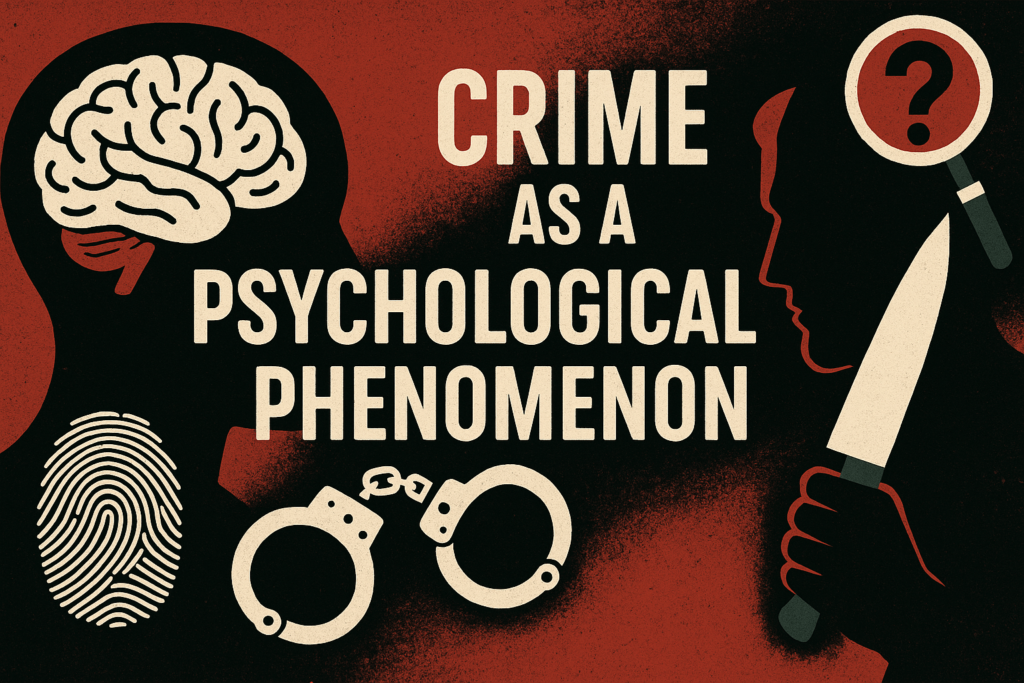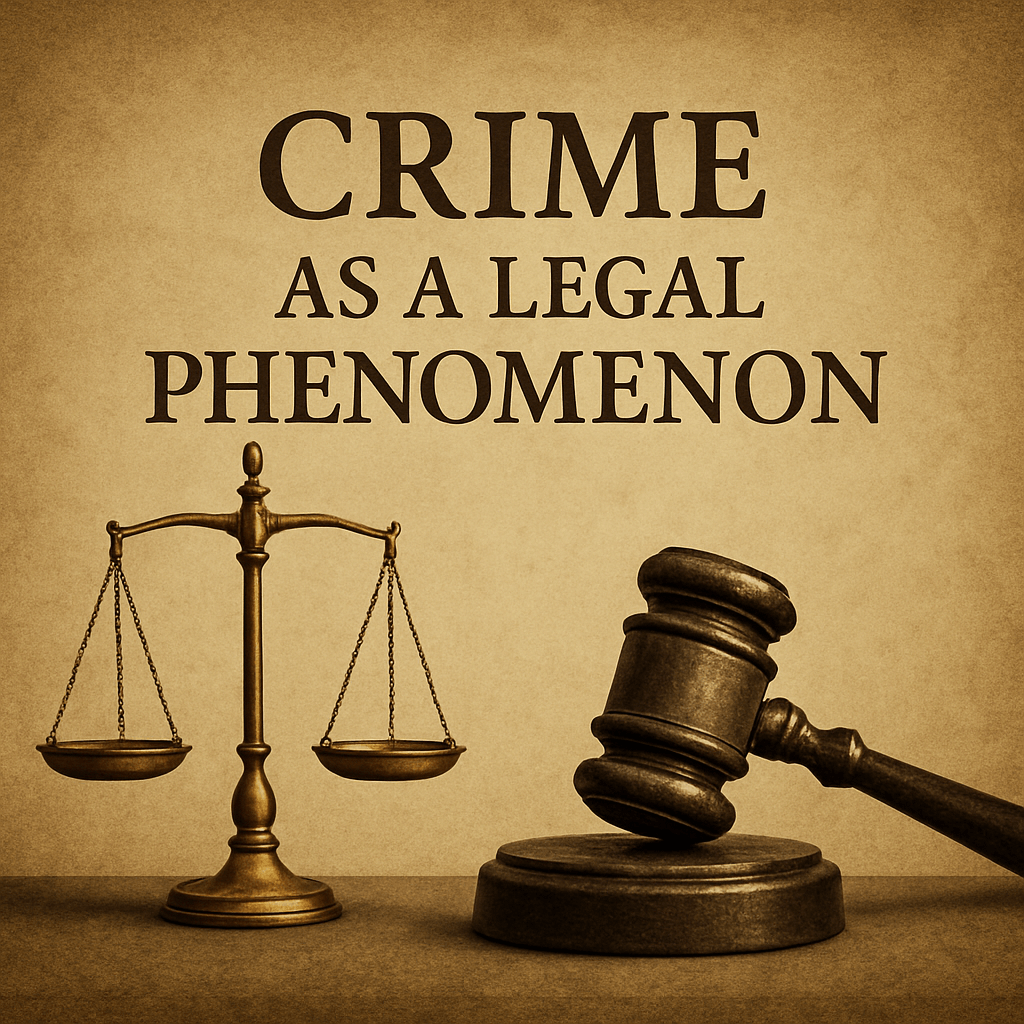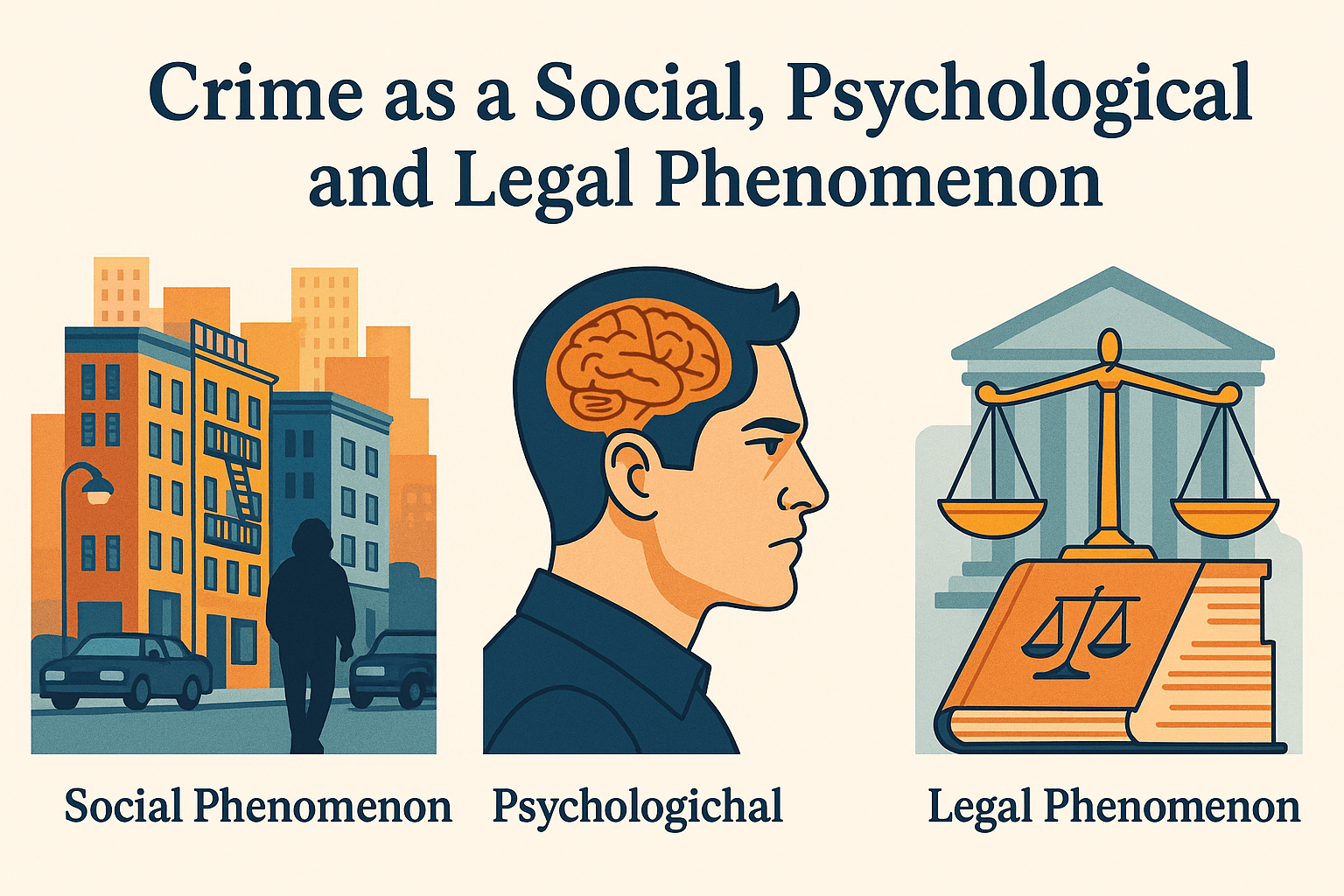Introduction
Crime is not merely the violation of written law—it is a mirror reflecting deeper societal, psychological, and institutional realities. Far from being a standalone incident, crime is a complex and layered occurrence, deeply rooted in historical, cultural, emotional, and legal frameworks. Every crime, whether minor or severe, carries behind it a series of causes and consequences, involving not just the offender and the victim, but families, communities, and entire institutions. It is a phenomenon that challenges our understanding of morality, justice, and human behavior.
In this article, we will examine crime from three major disciplinary lenses: the social, the psychological, and the legal. Each dimension offers a unique but interconnected explanation of why crime happens, how it is experienced, and how societies respond to it. By moving beyond surface-level explanations, we aim to highlight the depth and richness of criminological inquiry—emphasizing that meaningful strategies to reduce crime must address all these layers simultaneously.
1. Crime as a Social Phenomenon
Social Conditions and Structural Foundations of Crime
Crime frequently arises from specific social contexts. Individuals are shaped by the environments they inhabit, and areas plagued by poverty, systemic inequality, racial marginalization, and institutional failure often serve as incubators for criminal activity. Social disorganization—a condition where communities lack stable institutions like functioning schools, employment opportunities, or neighborhood cohesion—creates a void where deviant behavior can flourish. When the mechanisms of informal social control (like family guidance or community oversight) erode, individuals, especially youth, are more susceptible to influences that promote criminal conduct.
Take, for example, the high crime rates often seen in neglected urban centers. In these environments, the absence of economic opportunities and social mobility makes conventional goals—like education, stable employment, or homeownership—seem inaccessible. When individuals feel alienated from legitimate pathways to success, they may turn to illegitimate means, such as drug dealing, theft, or joining criminal networks. This condition is not accidental but rather the product of long-term neglect, segregation, and unequal distribution of power and resources.
Furthermore, when entire communities are repeatedly exposed to violence, poverty, and incarceration, a normalization of crime may develop. Youths grow up witnessing crime as a daily routine rather than a shocking anomaly. In this way, social environments shape not only opportunities for crime but also attitudes and justifications surrounding it.
Theoretical Perspectives on Crime and Society
Sociological theories offer structured explanations of how societal conditions produce criminal behavior. Robert Merton’s Strain Theory asserts that societal pressure to achieve culturally valued goals (like wealth or status), when unaccompanied by equal access to legitimate means, leads to strain. Individuals under strain may adapt in deviant ways—turning to crime as a way to fulfill societal expectations that are otherwise out of reach.
In contrast, Social Disorganization Theory, originating from the Chicago School, posits that certain neighborhoods inherently lack the social infrastructure needed to regulate behavior. Transient populations, economic instability, and racial heterogeneity contribute to weakened communal ties, making it difficult for residents to collectively respond to deviance. Such neighborhoods often become hotbeds for crime due to the absence of informal social control mechanisms.
Labeling Theory adds another layer by focusing on how society’s reaction to deviance can itself be criminogenic. When individuals are labeled as criminals, they are often rejected by mainstream society, which in turn reinforces deviant identity and restricts opportunities for reintegration. This can lead to a self-fulfilling prophecy, where the label not only reflects deviance but also perpetuates it.
These sociological perspectives highlight the idea that crime is not solely the product of individual choice but is also a reflection of broader structural inequalities, cultural norms, and institutional failures.
Culture, Peer Groups, and Crime Normalization
Cultural and peer influences significantly affect individual behaviors, particularly among adolescents and young adults. In marginalized communities or subcultures where crime is normalized—or even glamorized—individuals often find a sense of belonging and identity through deviant behavior. This process is especially evident in gang culture, where loyalty, toughness, and territorial dominance are rewarded, often through violence and illegal activities.
Media and pop culture further contribute to the social framing of crime. Violent video games, music that glorifies drug use or gang life, and sensationalized portrayals of criminals in movies and series can desensitize viewers to the seriousness of crime. More subtly, they may shape the moral framework of young people, leading them to view certain crimes as acceptable or even admirable.
Peer groups play a crucial role in reinforcing criminal behavior. When surrounded by delinquent peers, individuals often conform to group norms to gain acceptance. According to Differential Association Theory (Edwin Sutherland), criminal behavior is learned through interaction with others—particularly in intimate groups. This learning includes not only techniques for committing crimes but also motivations, rationalizations, and attitudes.
Criminality is not merely the result of individual pathology or personal choice—it is deeply rooted in social structures, cultural norms, and collective behaviors. As a social phenomenon, crime reflects the tensions, inequalities, and power dynamics present within a given society. From poverty and marginalization to lack of access to education and employment, various social conditions contribute to the emergence and persistence of criminal behavior. Sociological theories emphasize that crime must be understood in its broader context—where factors such as class conflict, community disintegration, and deviant subcultures play a pivotal role. This perspective encourages researchers and policymakers to shift their focus from punishing individuals to addressing the underlying social issues that fuel criminality.

2. Crime as a Psychological Phenomenon
Understanding the Criminal Mind and Internal Triggers
While social structures shape opportunities, the psychological dimension explores individual motivations and mental states. Why do some individuals, when placed in similar environments, choose to commit crime while others do not? Psychology examines this variance through the lens of cognitive processes, personality traits, emotional regulation, and behavioral conditioning.
Criminal acts often stem from distorted thinking patterns. Cognitive distortions—such as externalizing blame, minimizing the harm caused, or believing that rules don’t apply to oneself—are common among offenders. These thought processes can make individuals feel justified in their actions, thereby facilitating repeated offenses.
Moreover, personality disorders, particularly Antisocial Personality Disorder (ASPD) and psychopathy, are strongly associated with criminality. Individuals with these disorders typically exhibit traits such as impulsivity, lack of empathy, manipulativeness, and disregard for societal norms. Their inability to feel remorse or connect emotionally with others often allows them to inflict harm without internal conflict.
In addition to these traits, impulsive and emotionally dysregulated individuals—those who act without thinking or who struggle with anger—are also at increased risk of criminal behavior. Such tendencies are often rooted in early life experiences, trauma, or neurological differences.
Childhood Trauma, Abuse, and the Path to Criminality
A substantial body of psychological research underscores the impact of adverse childhood experiences (ACEs) on future criminal behavior. Children exposed to physical, emotional, or sexual abuse; chronic neglect; substance-abusing parents; or domestic violence are significantly more likely to engage in criminal activity during adolescence and adulthood.
These experiences disrupt normal emotional and cognitive development. Trauma affects brain structures involved in emotional regulation, decision-making, and social behavior, such as the amygdala, hippocampus, and prefrontal cortex. As a result, victims of early trauma may struggle with trust, exhibit hypervigilance, and react aggressively to perceived threats.
Moreover, the absence of positive role models and secure attachments during formative years limits the development of moral reasoning and empathy. Incarcerated populations, particularly those serving time for violent crimes, show disproportionately high rates of childhood trauma, suggesting a strong link between early abuse and later deviance.
Effective crime prevention, therefore, must include early interventions—such as trauma-informed therapy, family support programs, and school-based mental health services—to break the cycle of victimization and violence.
Cognitive and Behavioral Models of Criminal Learning
Social Learning Theory, formulated by Albert Bandura, posits that behavior is learned through observing others and the consequences of their actions. Children who grow up witnessing domestic violence or who observe adults achieving goals through criminal means may internalize these methods as legitimate coping strategies.
Behaviorism, particularly operant conditioning, emphasizes reinforcement: behaviors followed by rewards are likely to be repeated, while those followed by punishment tend to be extinguished. Unfortunately, in environments where criminal acts bring tangible benefits—money, status, peer approval—without immediate punishment, individuals are conditioned to continue offending.
Cognitive-behavioral therapy (CBT) has become a cornerstone of psychological rehabilitation in correctional settings. CBT targets the thinking patterns and learned behaviors that contribute to criminality, helping offenders reframe their actions, consider consequences, and develop healthier coping mechanisms.
Psychological interventions, when properly implemented, have been shown to reduce recidivism significantly, reinforcing the importance of addressing crime as a mental and emotional phenomenon—not just a legal infraction.

3. Crime as a Legal Phenomenon
Legal Definitions, Classifications, and the Philosophy of Law
At its core, crime is defined by the legal system: an act or omission that violates the law and is punishable by the state. This definition, while seemingly straightforward, is deeply rooted in societal values and political structures. Not every harmful act is considered criminal—for example, lying to a friend or cheating in a relationship may be unethical but not illegal. Conversely, actions deemed criminal in one jurisdiction may be legal in another, illustrating how legal definitions are shaped by cultural, historical, and political contexts.
The law typically categorizes crimes based on severity and nature. The broadest division includes felonies (serious crimes such as murder, rape, and armed robbery), misdemeanors (lesser offenses like petty theft or public intoxication), and infractions (minor violations like traffic offenses). Additional categories include violent crimes, property crimes, white-collar crimes, organized crime, cybercrime, and victimless crimes (e.g., consensual drug use). These classifications are not merely technical; they influence how the legal system allocates resources, assigns punishments, and designs rehabilitation efforts.
Philosophically, criminal law rests on several justifications for punishment: retribution (punishment as moral vengeance), deterrence (discouraging future crimes), rehabilitation (reforming the offender), incapacitation (removing dangerous individuals), and restoration (repairing harm through dialogue and restitution). Legal responses to crime reflect a balance—or sometimes a tension—among these competing goals, depending on a society’s priorities and values.
Mens Rea, Criminal Responsibility, and the Role of Intent
A fundamental principle of modern criminal law is that punishment should be based not only on the act itself (actus reus) but also on the mental state accompanying it (mens rea). The Latin term mens rea refers to the “guilty mind”—an intentional or negligent state of mind that demonstrates the individual’s awareness or recklessness regarding the criminal nature of their actions.
The law recognizes varying degrees of intent: purposeful, knowing, reckless, and negligent. For instance, someone who plans and deliberately executes a murder exhibits premeditated intent, while another who accidentally causes a death through reckless behavior may be charged with manslaughter rather than murder. The ability to differentiate between these mental states is essential for ensuring fairness and proportionality in the criminal justice system.
Criminal responsibility is also closely tied to mental capacity. If an individual is found to be legally insane at the time of the crime, they may be deemed not criminally responsible. This principle is based on the belief that people should not be punished if they lack the capacity to understand the nature or wrongfulness of their actions. For this reason, forensic psychological evaluations play a critical role in court proceedings, especially in cases involving violent or unusual behavior.
Moreover, the concept of diminished responsibility allows for reduced sentencing in cases where mental illness, intoxication, or cognitive limitations impair judgment without fully absolving the individual of guilt. These legal nuances ensure that punishment reflects not just the harm caused, but the moral blameworthiness of the offender.
The Evolution of Criminal Law and Legal Reform
Criminal law is not static—it evolves alongside societal values, technological innovations, and political ideologies. What was once criminalized may later be decriminalized or legalized. Consider the historical criminalization of homosexuality, interracial marriage, or abortion—once punished harshly by legal systems, these behaviors are now recognized as protected rights in many jurisdictions. This shift reflects a broader understanding that law is not just a tool of control, but also a mechanism for social change.
In recent decades, movements advocating for criminal justice reform have questioned the fairness and efficacy of harsh sentencing laws, especially those resulting from the “war on drugs” and mandatory minimum sentences. Critics argue that these policies disproportionately target marginalized communities and contribute to mass incarceration, particularly in countries like the United States.
Moreover, with the rise of the digital age, new legal challenges have emerged. Cybercrimes such as identity theft, hacking, online harassment, and digital piracy require legal systems to adapt rapidly. International collaboration becomes necessary as these crimes often transcend borders, raising complex questions about jurisdiction, privacy, and international law.
There is also growing interest in restorative justice, a model that emphasizes healing and accountability rather than punishment. In this approach, victims and offenders engage in structured dialogue, seeking to repair the harm done and prevent future offenses. This model is gaining traction in communities seeking alternatives to punitive justice—especially for non-violent offenses or youth crimes.

Conclusion
Crime is not a singular concept to be understood in isolation; it is a multidimensional phenomenon that intersects with the very core of how societies function and individuals behave. From a social perspective, crime often reflects deeper issues of poverty, inequality, cultural disintegration, and lack of opportunity. It is both a symptom and a consequence of structural failures, institutional neglect, and social exclusion. Sociological theories provide invaluable insights into how communities, cultures, and power dynamics influence the emergence of crime.
From a psychological angle, crime reveals the internal struggles, emotional wounds, and cognitive distortions that drive human behavior. It shows how mental health, trauma, personality traits, and learned behaviors can push individuals toward actions that violate legal and moral norms. By recognizing the psychological underpinnings of criminality, we move closer to strategies that treat root causes rather than just symptoms—through therapy, rehabilitation, and early intervention.
Legally, crime is defined, categorized, and managed by institutions that strive—sometimes imperfectly—to balance justice with compassion, deterrence with rehabilitation, and punishment with prevention. Legal definitions shape who gets labeled as a criminal, what acts are prioritized, and how power is distributed across society. As societies evolve, so too must their legal systems, ensuring that laws remain relevant, fair, and aligned with human rights.
Understanding crime through these three lenses—social, psychological, and legal—allows for a richer, more holistic grasp of its causes and consequences. It challenges simplistic notions of “bad people doing bad things” and instead invites us to ask deeper questions: What kinds of environments foster crime? How does the human mind process moral failure? How can the law evolve to reflect both justice and mercy?
In addressing crime, we must think systemically, act compassionately, and innovate legally. This means investing in communities, reforming institutions, treating trauma, and rewriting laws that no longer serve the public good. Crime may be inevitable in any society, but how we respond to it defines the kind of world we choose to build.
References
Merton, R. K. (1938). Social Structure and Anomie. American Sociological Review.
Sutherland, E. H. (1947). Principles of Criminology. J. B. Lippincott Company.
Becker, H. S. (1963). Outsiders: Studies in the Sociology of Deviance. Free Press.
Shaw, C. R., & McKay, H. D. (1942). Juvenile Delinquency and Urban Areas. University of Chicago Press.
Bandura, A. (1977). Social Learning Theory. Prentice-Hall.
Hare, R. D. (1993). Without Conscience: The Disturbing World of the Psychopaths Among Us. The Guilford Press.
Garland, D. (2001). The Culture of Control: Crime and Social Order in Contemporary Society. Oxford University Press.
Cullen, F. T., & Agnew, R. (2018). Criminological Theory: Past to Present. Oxford University Press.
Siegel, L. J. (2020). Criminology: The Core. Cengage Learning.

